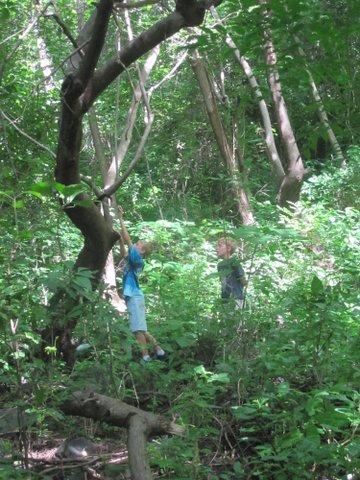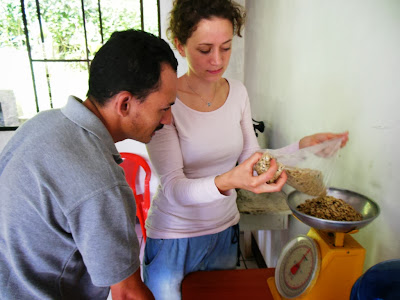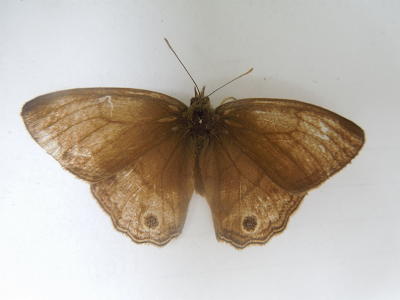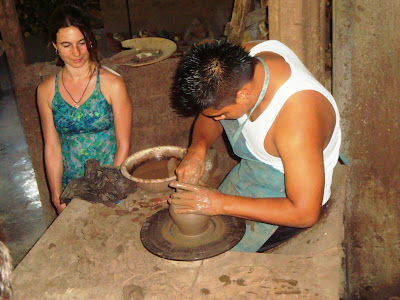It is human nature to love animals and want to be near them. Humans domesticated dogs from wolves over 10,000 years ago, for instance, and today the two are inseparable. But not all animals are evolved to live dependent upon humans, however. Our love of animals sometimes becomes a kind of fetish, in which we twist our appreciation and admiration into a desire to own and control. Wild animals, in general, do not make good pets. Trying to make a wild animal such as a monkey into a pet almost always ends badly.
 |
| A young child bonded with this monkey, but she knows it's best for the monkey to live and die in the jungle, where it can live wild. Photo Pablo Somarriba. |
Something may happen, however, that triggers in us a realization about something we had never considered before. Surely this was the case with a Nicaraguan family who decided on their own to place their pet monkey with us in the interest in having it return to the wild.
 |
| This white-faced capuchin monkey loved to run free, and now he lives with other monkeys of his kind, deep in the forests of Laguna de Apoyo Nature Reserve. Photo Pablo Somarriba. |
This monkey cared little for adults, but was gentle with children. He was rambunctious, and insisted in making a mess in the kitchen. We soon hoped that he would indeed want to find his kind and rejoin them in the wild! This wild animal rescue was a real challenge.Fortunately, we had volunteers available to attend him and even to help him return to the wild.
 |
| Our Spanish students-turned-environmental volunteers preparing for a monkey release mission. Photo Julie Akey. |
It amazes us at
GAIA how often well-educated people from the US and other developed countries end up with wild animals as pets when they come to Nicaragua to live. These people obviously are not thinking of the long-term welfare of the animal nor of the entire commodity chain in capture and sale of wild animals, when they purchase one of these poor animals that was stolen from its natural habitat. We often encounter foreigners in Nicaragua claiming to "rescue" the animals from the pet trade by purchasing them. Who do they think they are fooling?
 |
| This poor White-faced Capuchin was brought to Estacion Biologica for return to the wild. Photo Julie Akey. |
Sooner or later, these people face reality. An animal such as a white-faced monkey is not the same as a dog. Its ancestors did not live hundreds of generations in dependence upon humans. The monkeys are wild animals and putting one in a cage or on a chain does not domesticate it. The animal suffers in captivity and usually, the owners do, too.
 |
| Our volunteers carry the white-faced capuchin monkey through the forest to a site inhabited by a troop of its same species, to be re-united with its friends. Photo Julie Akey. |
Recently, we received such a donation. A white-faced capuchin (
Cebus capucinus), friendly enough and very active, was nonetheless, no longer invited by its owners to be a captive animal. We are amazed athow easily people can "un-adopt" their animals, but so be it, this one was brought to us in that way. We agreed to take the animal, and we immediately contacted the local office of the Ministry of Natural Resources that this animal was a likely candidate to return to the wild.
After a week of observation, we decided that this guy could make it in the wild, if he could only re-integrate with a group of his species. There has been plenty of good news over the past few years regarding the white-faced capuchin populations, which also encouraged us to release him here. Once reduced to three small groups in precipitous canyons along the western side of the lake, the populations have been expanding and even colonizing new areas. We have even sighted a small group in the north section of the reserve, directly behind
Estacion Biologica, with an infant born in early 2013.
 |
| FUNDECI/GAIA staff member Elmer Nicaragua observes a group of white-faced capuchins nearby, assessing where and when to release the rescue animal to make contact with the group. Photo Julie Akey. |
White-faced capuchins are very intelligent animals. They often use tools in the wild, using rocks to break open seed pods. Their social hierarchies have been the subjects of numerous scientific studies. They live many decades in captivity, often exceeding fifty years age.
 |
| The released white-faced capuchin monkey begins his first steps as a free animal in many years. Photo Julie Akey. |
Because this animal had been accustomed to humans, we chose to release him into a troop located far from any houses, in the southwestern corner of Laguna de Apoyo Nature Reserve. The largest troop of this species is found there. The release required a drive in our sturdy Land Rover, followed by a hike through the forest to reach a troop and then assess the situation. Elmer Nicaragua, accompanied by the students of Apoyo Spanish School, found the troop easily and there made the release.
 |
| Unlike their close relatives the Golden-mantled howler monkeys, white-faced capuchins often make their way to the ground where they forage for fruits and arthropods, turning over leaves and rocks. Photo Julie Akey. |
As we expected, the monkey was quite timid in the new, wild surroundings. After some time on the ground, he ascended the trees where his new friends were watching. Another wild animal returned to his place in Nicaragua!
 |
| Another wild animal release has been made! Photo Julie Akey. |
Releasing a wild animal is always a nervous scene. The wild is full of predators and prey, and any animal new to its surroundings is likely to become prey quickly. Our objective is to give the animal an opportunity to integrate into its environment with appropriate skills to survive especially until making its way into the community. We were relieved with the monkey scaled a tree and began acting like the wild animal we hoped he would remember he was.
 |
| Our rescue animal examines his surroundings with other monkeys observing him from nearby trees. Photo Julie Akey. |
 |
| Higher is better, up he goes! Photo Julie Akey. |
 |
| Now he's looking like a wild animal again. Photo Julie Akey. |
 |
| The monkey moves from tree to tree, exploring cautiously but surely. Photo Julie Akey. |
We at
FUNDECI/GAIA promote the protection of the wild areas of Nicaragua and the flora and fauna found in them. Learning how to appreciate our wild nature is a process, and we are learning as we go, too. We are happy when we can make a small contribution.
 |
| Our volunteer helpers in the animal release watch the monkey as he adapts to his new home in the forest. Photo Julie Akey. |
Would you like to help us with
wild animal rescue? We need funding to build cages for more animals, such as monkeys and
squirrels, and purchase special foods such as cashews for our macaws. We also need assistance in care for the animals-volunteers are especially welcome. You can
donate here, or
volunteer here!
























































